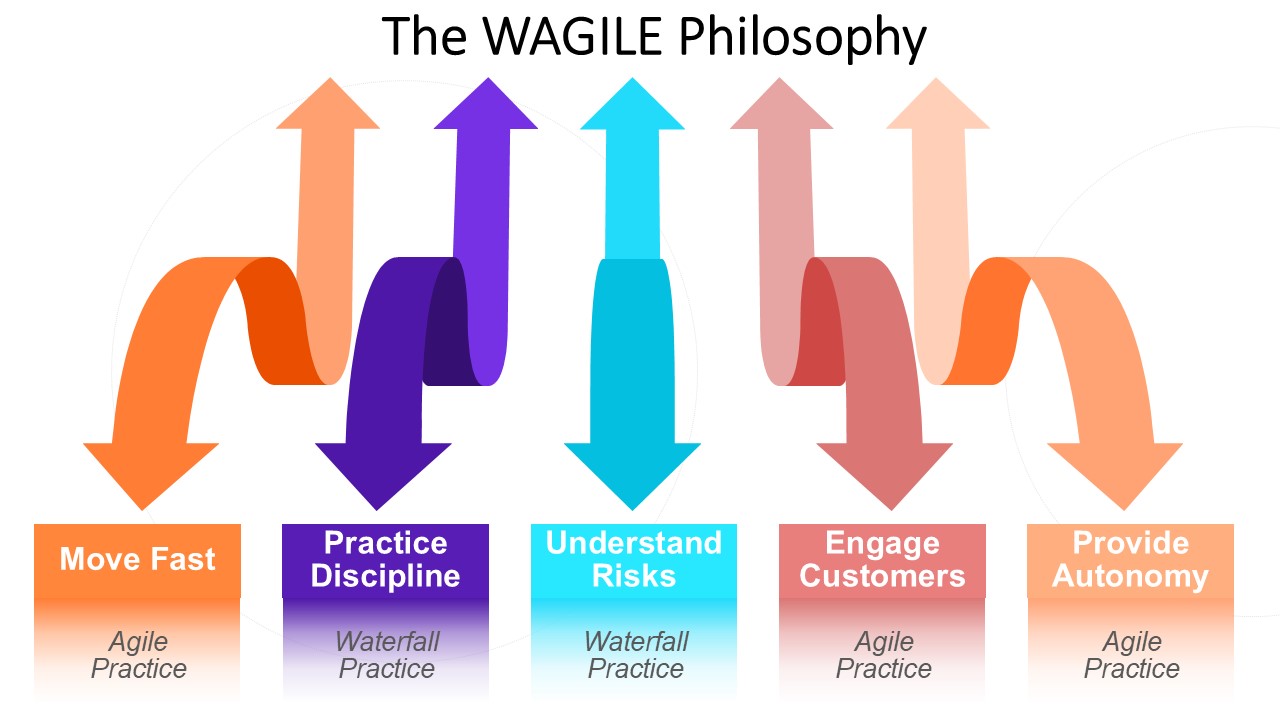If your project management teams are struggling with time-to-market, consider applying Lean NPD principles or the WAGILE Product Development process. Read about WAGILE Product Development in Part 3 of The Innovation PROCESS Book. WAGILE integrates customer feedback continuously throughout the process but maintains the structure of stages and gates from waterfall to offer decision security to upper management. Lean NPD works better for organizations in B2B without intimate customer and end-user interactions. (Read about Lean NPD in Part 4 of The Innovation PROCESS Book.) Both hybrid processes focus on collaboration among cross-functional teams.
WAGILE Product Development Principles
WAGILE combines waterfall (“W-“) with Agile (“-agile”) to offer both flexibility and discipline in the NPD process. The key principles of WAGILE are as follows (read more here).
- Move fast to gain competitive market share,
- Practice discipline via stages and gates in the NPD process,
- Understand risk and create mitigation plans,
- Engage customers to ensure new products are delighting to them, and
- Provide autonomy by letting team members work within their boundaries of expertise.
Each stage of work in WAGILE Product Development stands alone with decisions made at selective gate reviews. Customer input is required at each phase of work. Iterations are optional within a stage of work to address sticky problems or to finalize results. However, unlike Scrum implementations of Agile in the software world, iterations (sprints) are utilized only when necessary.
Gate decisions are exit gates so that not only is the prior stage of work reviewed, but more importantly, the next phase of work is approved. Passing a gate review, therefore, means that the project is adequately resourced for the next phase of activities.
Lean NPD Principles
Lean New Product Development is built from the ideas of Lean Manufacturing. At the core, Lean is designed to reduce waste, increase productivity, and improve efficiency. In NPD, the biggest waste that occurs is waste of knowledge. Project timelines also tend to slip when there are too many unnecessary meetings and too many levels of review or approval.
Implementation of Lean NPD occurs in many different ways. My preferred execution of Lean NPD involves active, cross-functional teams that collaborate throughout the project. Instead of document-heavy gate reviews that come with risk-averse, large organizations, Lean NPD reviews rely upon high-level project boundaries. These “boundary conditions” may include cost, expected revenue, target customers, and time-to-market. Senior management reviews and approves the team’s collaborative goals for these boundary conditions. As long as the team does not deviate from the high-level goals (boundary conditions), they work autonomously to develop the new product.
Lean NPD requires trust between senior management and the working teams. Organizations with more open cultures and understanding of investment risk can benefit from Lean NPD.
Learn More
Please register for my presentation titled What’s In Between? Hybrid Agile Processes for Product Development with the Central Illinois Chapter of the Project Management Institute on April 8, 2025. Click here to register.
Feel free to contact me at info@globalnpsolutions.com if your organization is struggling to find the right balance between culture, risk, and innovation maturity in new product development. We can quickly implement a hybrid NPD process that fits your strategic goals and improves time-to-market.
© 2022-2025 Global NP Solutions, LLC
Building Innovation Leaders

